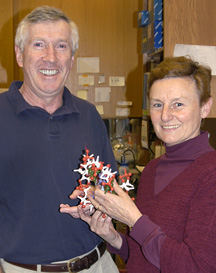

Study Reveals Process Linking Disordered Protein Folding and Binding
By Eric Sauter
A group of scientists at The Scripps Research Institute and the Skaggs Institute for Chemical Biology have uncovered one of the processes by which disordered or unstructured proteins become bound to specific cellular sites. The findings offer valuable insights into how proteins carry out their genetically encoded functions, and may provide promising new targets for future drug development.
The study was published May 23, 2007, in an advance online edition of the journal Nature.
"Our study offers the first solid glimpse into the process that links folding and target site binding by an intrinsically unstructured protein," said Peter Wright, chair of the Scripps Research Department of Molecular Biology, who led the research. "By applying advanced nuclear magnetic resonance (NMR) technology, we were able to show how disordered proteins recognize their targets and bind to them. As a result, we now know that the old dogma—that a defined protein structure equals protein function—is no longer the rule. A substantial number of proteins have large unstructured regions that are deeply involved in protein to protein interactions."
Intrinsically disordered proteins have long stretches of amino acids that are not held together in a single stable structure, as many of the more familiar proteins are. Because many possible structures are available to these proteins, they are capable of a wide range of functions, for which they may take up quite different structures. Proteins involved in signaling, transcriptional regulation, and cell-cycle regulation frequently contain such intrinsically unstructured regions. However, many of these same proteins are also involved in diseases like cancer or protein folding disorders such as Parkinson's or Alzheimer's diseases. One recent estimate suggests that as many as 30 percent of all human proteins are intrinsically disordered.
The study showed that the phosphorylated kinase inducible activation domain of the transcription factor CREB, a protein involved in the activation of target genes, forms an ensemble of transient interactions on binding to the KIX domain of the CREB protein. This behavior, the study said, suggests a transient state in which the two molecules are held together by rapidly changing interactions as they search for the right contacts to reach a fully bound and stable state. These transient complexes evolve by way of an intermediate phase to the fully bound state without breaking loose from KIX. In this intermediate or transient state, the activation domain is only partially folded, and completes the process in the final bound state.
For a number of important eukaryotic proteins, folding and binding are closely linked processes. These proteins can move from a disordered or unfolded state into a folded or ordered structure (folded proteins are described as being in their native state) only after binding to their cellular targets. Although poorly understood, it has been suggested that the mechanism that links folding to binding may be enhanced by what has been described as a 'fly-casting' effect—the disordered protein binds weakly and non-specifically to its target and begins folding only as it approaches the specific binding site. This is precisely what the new study found.
"These disordered regions go through a number of very non-specific interactions with non-specific targets—the 'fly casting', proposed by Dr. Peter Wolynes of UCSD [the University of California, San Diego]," Wright said. "When you cast your fly widely over the river, you cover a lot of surface area and eventually the fish will bite. In this case, it's the fish that reels you in. The disordered protein thrashes about, finds the right target, and the target—the specific binding site—draws the protein to it."
"The primary target of modern drug design is protein-protein interaction," said Professor Jane Dyson, a Scripps Research scientist who collaborated on the study, "but there are very few drugs that can inhibit these interactions specifically. Disordered proteins might provide an attractive new target for small molecules that could compete with the binding and folding process we've uncovered."
"By studying additional disordered protein complexes, we may be able to firmly establish whether or not this process of coupled folding and binding is common to all eukaryotic proteins," Dyson added, "or if alternative mechanisms, such as conformational or shape selection, may also play a significant role."
Kenji Sugase of The Skaggs Institute for Chemical Biology and the Scripps Research Institute and the Suntory Institute for Bioorganic Research (Japan) also contributed to the study, Mechanism of Coupled Folding and Binding of an Intrinsically Disordered Protein.
The study was supported by the National Institutes of Health and the Skaggs Institute for Chemical Biology.
Send comments to: mikaono[at]scripps.edu
 "By applying advanced nuclear magnetic resonance (NMR) technology, we were able to show how disordered proteins recognize their targets and bind to them," says Molecular Biology Chair Peter Wright, shown here with one of the Nature paper co-authors Professor Jane Dyson.
"By applying advanced nuclear magnetic resonance (NMR) technology, we were able to show how disordered proteins recognize their targets and bind to them," says Molecular Biology Chair Peter Wright, shown here with one of the Nature paper co-authors Professor Jane Dyson.
